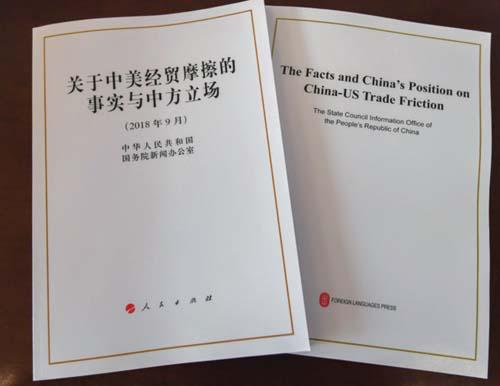Unwise Moves
2018-10-31ByYuShujun
By Yu Shujun


U.S. President Donald Trumps trade battle with China has no end in sight and seems to have gone beyond tariffs. After imposing tariffs on $250 billion of imports from China, Trump threatened to “levy even more, with the possibility of substantially more than doubling that number.”
Then in a speech on October 4, Vice President Mike Pence launched a broader attack, accusing China of intellectual property (IP) theft, military aggression and attempts to interfere in the upcoming U.S. midterm elections.
“The lack of trust in the U.S. about China and the lack of knowledge is so profound that the tension is not only going to stay on trade,” Peter Walker, a former senior partner at McKinsey & Company, told the media on the sidelines of the 2018 U.S.-China Relations Conference held at Columbia University in New York, on October 7. “Its going to expand to IP issues and all issues related to it.”
Pillars undermined
Huang Yasheng, a professor at the Sloan School of Management of the Massachusetts Institute of Technology, said China is being blamed for manufacturing job losses in the U.S. The allegation has created a political backlash against globalization and against China. Chinese investments are being restricted as well as its labor market, with visas for foreign workers and green cards being curtailed. There are also product market restrictions as a result of slapping tariffs on Chinese goods.
However, economic evidence suggests that the problems and job losses in the U.S. manufacturing industry are overwhelmingly due to technology rather than globalization, Huang said. “It is entirely wrong to blame this issue on China. This should not be one of the important components driving the relationship between the two countries downhill,” he added.
Huang pointed out that the economy, trade and investment, people-to-people interaction and mobility of goods and capital are the pillars of the China-U.S. relationship that could withstand shocks. With these stabilizing pillars, both countries were able to resolve their diffi culties in the past. “We have benefi ted from the pillars,” he said. “All these pillars now are being substantially undermined.”
Lack of trust
Walker said a fundamental distrust due to the differences in the two countriesmodels is deeper than the “noise” about trade and the South China Sea issue.“Even though both [Chinese and U.S.] models have been very successful, theres a deep level of mistrust,” he said, with their core difference leading to significant misperceptions. China has a strong central government that is formed based on a meritocracy, Walker added. Having a corporate-driven model, with consensus in decision-making and a long-term view, Chinas economic results are not at all surprising.

Walker said the biggest takeaway from his 80 trips to China in 15 years is the total disconnect between what he sees in China—a happy people proud of Chinese accomplishments and a prosperous country—and what he reads in the Western press about China: unhappy people and an unsustainable government and economy.“If you look at what China has accomplished… huge improvements in literacy, longevity and the raising of people out of poverty… the notion of the average Chinese protesting the government is like out of your mind,” he said.
Another misconception is the idea that China is militaristic, Walker said. “China has the most peaceful history of any major country over thousands of years…Their defense budget is a tiny fraction of the U.S. defense budget, even though they have almost four times as many people as the U.S. does.” He added that the U.S. has been spending $14 trillion on military excursions over the last 30 years, whereas the money required to fi x the infrastructure in the U.S. is $2 trillion.
Much of the anxieties about China in the West, starting in the U.S., go back to a fundamental misunderstanding, he said, citing the fact that while 26 million Chinese have visited the U.S., less than 1 million people from the United States have been to China. For him, 95 percent of the mistrust is on the side of the U.S. “The U.S. doesnt understand [China]. It never really invested time to understand China,” he told Beijing Review.
Possible solutions
The panelists thought the tariffs were a“stupid” measure. Trade enables a country to export products based on its strength and to import whats done better elsewhere, either with better quality or a better price or both, Walker explained. The trade deficit between the two countries isnt a meaningful number. The U.S. exports enormous volumes of services to China but doesnt count that while calculating the defi cit, Walker said.
“Trade restrictions are lose-lose. Only Trump could decide that losing less than the other side was really a win,” he said.“Every economist knows that both economies suffer with restrictions. Trump is using the card for political reasons and appears to be successful.”
Huang said a wise administration would take a case-by-case approach. “I would like to see a more tailored and targeted solution rather than slapping 20 percent tariffs on Chinese products, which really hurt enterprises that have nothing to do with technology transfer and IP issues,” he said.“If you have these concrete issues on the table, the Chinese will be willing to discuss these issues.”

He added that the situation of IP theft in China is being controlled. “The danger of the U.S. policy now is to mix IP theft issues with compulsory licensing issues, making themselves enemies of those Chinese domestic entrepreneurs who start to gain from better IP protection.”
The two countries conducted negotiations in June and August with those issues on the agenda. “Theres been a lot of discussion in many areas,” Cui Tiankai, Chinese Ambassador to the United States, told National Public Radio on October 3. According to Cui, China offered to reduce the trade defi cit with the U.S., presenting a proposal on further reform and opening up. But the tentative agreement was rejected overnight and the demand from the U.S. changed, he said.
“The Chinese are very pragmatic,”Walker said. “If we offer China things that really matter to them, China will be willing to think about opening up financial and service markets in response.” Chinese gov- ernment officials, he said, see enormous opportunities for win-win cooperation, whether in fighting climate change, technology or managing the transition to the next consumer economy driven by technology and artifi cial intelligence.
Merit Janow, Dean of Columbia Universitys School of International and Public Affairs, said she didnt anticipate any reduction of the trade tension in the near term. It was not only a question of the U.S. midterm elections. Some of these issues have been sources of tension for a very long time, she said.
“It would be unrealistic to expect a fundamental resolution in the near term but that does not mean that we cannot see some progress,” Janow told the media on the sidelines of the forum. “My hope is we get progress where we can and keep working on those [problematic] areas that remain.”
